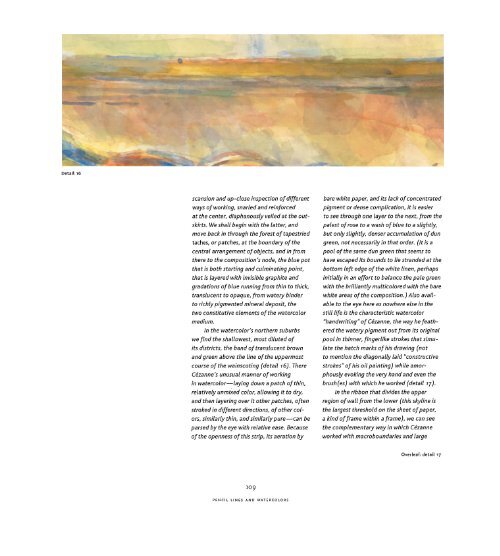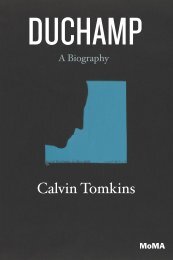Still Life in Watercolors
qbj8dgc
qbj8dgc
- No tags were found...
You also want an ePaper? Increase the reach of your titles
YUMPU automatically turns print PDFs into web optimized ePapers that Google loves.
Detail 16<br />
scansion and up-close <strong>in</strong>spection of different<br />
ways of work<strong>in</strong>g, snarled and re<strong>in</strong>forced<br />
at the center, diaphanously veiled at the outskirts.<br />
We shall beg<strong>in</strong> with the latter, and<br />
move back <strong>in</strong> through the forest of tapestried<br />
taches, or patches, at the boundary of the<br />
central arrangement of objects, and <strong>in</strong> from<br />
there to the composition's node, the blue pot<br />
that is both start<strong>in</strong>g and culm<strong>in</strong>at<strong>in</strong>g po<strong>in</strong>t,<br />
that is layered with <strong>in</strong>visible graphite and<br />
gradations of blue runn<strong>in</strong>g from th<strong>in</strong> to thick,<br />
translucent to opaque, from watery b<strong>in</strong>der<br />
to richly pigmented m<strong>in</strong>eral deposit, the<br />
two constitutive elements of the watercolor<br />
medium.<br />
In the watercolor's northern suburbs<br />
we f<strong>in</strong>d the shallowest, most diluted of<br />
its districts, the band of translucent brown<br />
and green above the l<strong>in</strong>e of the uppermost<br />
course of the wa<strong>in</strong>scot<strong>in</strong>g (detail 16). There<br />
Cezanne's unusual manner of work<strong>in</strong>g<br />
<strong>in</strong> watercolor—lay<strong>in</strong>g down a patch of th<strong>in</strong>,<br />
relatively unmixed color, allow<strong>in</strong>g it to dry,<br />
and then layer<strong>in</strong>g over it other patches, often<br />
stroked <strong>in</strong> different directions, of other colors,<br />
similarly th<strong>in</strong>, and similarly pure—can be<br />
parsed by the eye with relative ease. Because<br />
of the openness of this strip, its aeration by<br />
bare white paper, and its lack of concentrated<br />
pigment or dense complication, it is easier<br />
to see through one layer to the next, from the<br />
palest of rose to a wash of blue to a slightly,<br />
but only slightly, denser accumulation of dun<br />
green, not necessarily <strong>in</strong> that order. (It is a<br />
pool of the same dun green that seems to<br />
have escaped its bounds to lie stranded at the<br />
bottom left edge of the white l<strong>in</strong>en, perhaps<br />
<strong>in</strong>itially <strong>in</strong> an effort to balance the pale green<br />
with the brilliantly multicolored with the bare<br />
white areas of the composition.) Also available<br />
to the eye here as nowhere else <strong>in</strong> the<br />
still life is the characteristic watercolor<br />
"handwrit<strong>in</strong>g" of Cezanne, the way he feathered<br />
the watery pigment out from its orig<strong>in</strong>al<br />
pool <strong>in</strong> th<strong>in</strong>ner, f<strong>in</strong>gerlike strokes that simulate<br />
the hatch marks of his draw<strong>in</strong>g (not<br />
to mention the diagonally laid "constructive<br />
strokes" of his oil pa<strong>in</strong>t<strong>in</strong>g) while amor-<br />
evok<strong>in</strong>g the very hand and even the<br />
phously<br />
brush (es) with which he worked (detail ij).<br />
In the ribbon that divides the upper<br />
region of wall from the lower (this skyl<strong>in</strong>e is<br />
the largest threshold on the sheet of paper,<br />
a k<strong>in</strong>d of frame with<strong>in</strong> a frame), we can see<br />
the complementary way <strong>in</strong> which Cezanne<br />
worked with macroboundaries and large<br />
Overleaf: detail 17<br />
109<br />
PENCIL LINES AND WATERCOLORS




